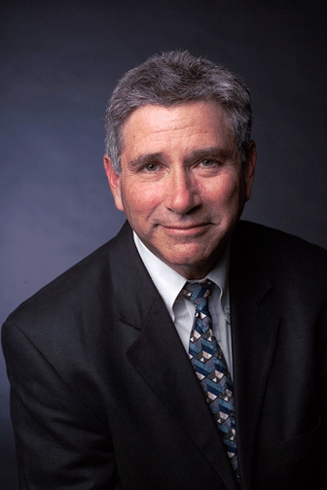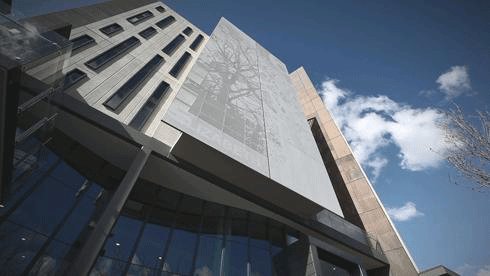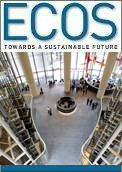
|
Published: 13 March 2012
Workspaces that work for people: an interview with Frank Becker
Professor Frank Becker of Cornell University works in the field of ‘organisational ecology’. This new discipline understands that physical workspaces both shape and are shaped by the humans who use them. Prof. Becker recently visited Australia as a guest of the Green Building Council of Australia. Michele Sabto asked him how we might use insights from organisational ecology to maximise the benefits of our growing stock of green buildings.

|
|
Professor Frank Becker Credit:
Brookfield Multiplex
|
Imagine you are the CEO of a company that has just moved into a brand new ‘green’ building. Your company has spent a lot of money on the build, and the new offices are full of features designed to improve not only the energy efficiency of the building, but also the working life of employees.
But, things aren’t going to plan. Your employees aren’t opening the windows, designed to enable them to regulate the air temperature. Nobody is using the bright, inviting stairwells, aimed at encouraging physical activity and reducing the energy required to run lifts. And, people are grumbling about the lack of privacy in the new open-plan offices, which were designed to encourage interaction between workers and reduce the building materials that would otherwise have been used for internal partitions. In short, your staff seem uninterested in the building’s green features and don’t use them.
This is a real-life example provided by Prof. Becker in a recent presentation to the Green Building Council of Australia (GBCA). In the field of organisational ecology, physical design is understood as something that both shapes and is shaped by work processes, organisational culture, demographics and information technologies. According to Prof. Becker, the above scenario – or versions of it – is common.
What has gone wrong in this scenario you have given us?
‘From my point of view – if you’re really interested in sustainability – sure, you have to put in the right technical systems, but you also have to deal with the people. Too often we don’t really understand the people these buildings are built for.
‘What is often required, in parallel with the design of a new building, is an “enculturation process”: a transformation of the organisation’s culture, and active encouragement by management of behaviour change.’
You have experience in many sectors, including housing, corporate offices and health care. Can you give us an example of an ‘enculturation’ strategy that you believe was successful in one of these sectors?
‘Much of my work has been in helping organisations move from traditional closed offices or cubicles to more open “activity-based” work spaces.
‘To give you one example, I worked with a high-technology company in California where people weren’t used to the new workspaces. They weren’t sure how it would work and they didn’t know how they would deal with privacy issues and with the fact that status was going to be much less spatially indicated. So one of the things we did there was, we not only talked with people, we gave them scenarios that they could practice and discuss, in advance of actually using the space.
‘We asked, for example, “What would you do if you were in this situation and you were trying to do some work and there was a person making a distracting noise? Where would you go and how would you relate to that person?”
‘And, we got them to develop what we called “behavioural protocols”. They worked out the rules about what was fair to ask of another person, or what would you expect yourself to do.’
Can this translate into helping organisations occupy green buildings more effectively?
‘We know that people invest money in creating environments that aren’t used at all. There is no question that you can apply the same principles to how people use green buildings as you do when you are asking them to move from more traditional offices to activity-based working. You can apply that to getting people to change their own behaviour to get the most out of a sustainable building.’
What are the upcoming challenges for the field of organisational ecology in terms of buildings and their uses?
‘I’m really interested in what I call “synergetic design”. This is design that works on multiple social levels to accommodate working and living spaces that are designed to meet multiple needs.’
One local example I can think of might be the CommonGround supportive housing model, which houses medical, employment and counselling services under one roof. In Melbourne, the Elizabeth St Common Ground building is 5-green star rated and includes an internal atrium that ventilates apartments, and a green roof that provides insulation for the building. Is that the kind of thing you are talking about?
‘Right. This is design that works on multiple social levels that go beyond the individual building, the individual and the organisation. I’m interested in design that touches the surrounding community, and is integrated and involved in it.
‘The focus here is about how we make connections. How do we create community-wide integrated living, working and healing spaces in which we don’t make distinctions that lead us to say, for example, “oh, it’s only in a hospital that you deal with health and wellbeing”, or “it’s only in schools where you deal with learning”, or “it’s only in a workplace where you deal with work”. In fact, these boundaries are much more permeable.’
How does this approach tie in with the policy context, say in health care or workplace relations, in the United States?
‘The direction in which health care in the United States and Europe is going is to ask, “how do we keep people out of hospitals as much as possible? How do we bring the care to the people rather than the people to the care? Much of this is about the positive aspects of wellbeing. It brings attention to food sources, recreation sources, to the notion of a full life, as opposed to each of these areas having their own box.
‘In my GBCA presentations to Australian audiences, I gave the example of a hospital in Singapore that has a large rooftop garden partially run by neighbouring apartment owners. Another is a hospital in the United States that is running a healthy eating outreach program for the local community, teaching families and young children raised on takeaway how to cook nutritious meals from fresh produce grown in onsite kitchen gardens.’
In your GBCA presentation, you noted that the CEO of the United States hospital who drove those changes came from the hospitality industry, not the medical field. Is this significant?
‘I don’t think anyone from a healthcare field would think the way that CEO did. One of the things we’ve learnt about innovation is that often real innovation comes from people who come from an “other” discipline or background and are able to integrate that into the context in which they’re working. Because they haven’t been trained to think in a particular way, opportunities exist in their minds that wouldn’t otherwise. This CEO came with a customer focus, rather than a medical model.’
Prof. Becker is a lecturer at Cornell University, and is Director of the International Workplace Studies Program (IWSP), and Co-Director of the Design Concepts Laboratory (DCL), both at Cornell University. On his recent visit to Australia, Prof. Becker spoke at forums hosted by the GBCA in Melbourne, Brisbane and Sydney, and was a keynote speaker at the Green Cities 2012 Conference in Sydney.




